A Novel Flexible Liquid Metal Microheater with a Textured Structure
Abstract
:1. Introduction
2. Materials and Methods
3. Experimental Principle and Procedure
4. Results and Discussion
4.1. Experimental Results
4.2. Microheaters with Textured Structure vs. Microheaters with Parallel Ventilating Side Channels
4.3. Analysis and Discussion
4.4. Stretching and Bending Test
4.5. Application
5. Conclusions
Supplementary Materials
Author Contributions
Funding
Data Availability Statement
Conflicts of Interest
References
- Neda, T.; Nakamura, K.; Takumi, T. A polysilicon flow sensor for gas flow meters. Sens. Actuators A-Phys. 1996, 54, 626–631. [Google Scholar] [CrossRef]
- Bhattacharyya, P.; Basu, P.K.; Mondal, B.; Saha, H. A low power MEMS gas sensor based on nanocrystalline ZnO thin films for sensing methane. Microelectron. Reliab. 2008, 48, 1772–1779. [Google Scholar] [CrossRef]
- Wu, J.; Tao, K.; Miao, J.; Norford, L.K. Improved Selectivity and Sensitivity of Gas Sensing Using a 3D Reduced Graphene Oxide Hydrogel with an Integrated Microheater. ACS Appl. Mater. Interfaces 2015, 7, 27502–27510. [Google Scholar] [CrossRef] [PubMed]
- Long, H.; Harley-Trochimczyk, A.; Pham, T.; Tang, Z.; Shi, T.; Zettl, A.; Carraro, C.; Worsley, M.A.; Maboudian, R. High Surface Area MoS2/Graphene Hybrid Aerogel for Ultrasensitive NO2 Detection. Adv. Funct. Mater. 2016, 26, 5158–5165. [Google Scholar] [CrossRef]
- Han, J.-W.; Meyyappan, M. A Built-In Temperature Sensor in an Integrated Microheater. IEEE Sens. J. 2016, 16, 5543–5547. [Google Scholar] [CrossRef]
- du Plessis, M.; Clasen, E.; Land, K.; Joubert, T.-H. Micro-incubator for bacterial biosensing applications. In Proceedings of the Fourth Conference on Sensors, MEMS, and Electro-Optic Systems, Skukuza, South Africa, 18–20 September 2016. [Google Scholar]
- Liu, L.; Cao, W.; Wu, J.; Wen, W.; Chang, D.C.; Sheng, P. Design and integration of an all-in-one biomicrofluidic chip. Biomicrofluidics 2008, 2, 34103. [Google Scholar] [CrossRef]
- Arata, H.F.; Rondelez, Y.; Noji, H.; Fujita, H. Temperature alternation by an on-chip microheater to reveal enzymatic activity of beta-galactosidase at high temperatures. Anal. Chem. 2005, 77, 4810–4814. [Google Scholar] [CrossRef]
- Choi, S.; Park, J.; Hyun, W.; Kim, J.; Kim, J.; Lee, Y.B.; Song, C.; Hwang, H.J.; Kim, J.H.; Hyeon, T.; et al. Stretchable Heater Using Ligand-Exchanged Silver Nanowire Nanocomposite for Wearable Articular Thermotherapy. ACS Nano 2015, 9, 6626–6633. [Google Scholar] [CrossRef]
- Jang, J.; Hyun, B.G.; Ji, S.; Cho, E.; An, B.W.; Cheong, W.H.; Park, J.-U. Rapid production of large-area, transparent and stretchable electrodes using metal nanofibers as wirelessly operated wearable heaters. NPG Asia Mater. 2017, 9, e432. [Google Scholar] [CrossRef]
- Baptista, A.; Silva, F.; Porteiro, J.; Míguez, J.; Pinto, G. Sputtering Physical Vapour Deposition (PVD) Coatings: A Critical Review on Process Improvement and Market Trend Demands. Coatings 2018, 8, 402. [Google Scholar] [CrossRef]
- Pessoa, R.S.; Fraga, M.A.; Santos, L.V.; Galvão, N.K.A.M.; Maciel, H.S.; Massi, M. Plasma-assisted techniques for growing hard nanostructured coatings. In Anti-Abrasive Nanocoatings; Woodhead Publishing: Thorston, UK, 2015; pp. 455–479. [Google Scholar]
- Liu, S.; Wang, J.; Zeng, J.; Ou, J.; Li, Z.; Liu, X.; Yang, S. “Green” electrochemical synthesis of Pt/graphene sheet nanocomposite film and its electrocatalytic property. J. Power Source 2010, 195, 4628–4633. [Google Scholar] [CrossRef]
- Gharesi, M.; Ansari, M. Tin Oxide Microheater for Chemical Sensors. IOP Conf. Ser. Mater. Sci. Eng. 2016, 108, 012018. [Google Scholar] [CrossRef]
- Tserepi, A.; Moschou, D.; Vourdas, N.; Filippidou, M.K.; Tsouti, V.; Kokkoris, G.; Tsekenis, G.; Zergioti, I.; Chatzandroulis, S.; Tserepi, A.; et al. Integrated biochip for PCR-based DNA amplification and detection on capacitive biosensors. In Proceedings of the Bio-MEMS and Medical Microdevices, Grenoble, France, 25–26 April 2013. [Google Scholar]
- Kaigala, G.V.; Behnam, M.; Bidulock, A.C.; Bargen, C.; Johnstone, R.W.; Elliott, D.G.; Backhouse, C.J. A scalable and modular lab-on-a-chip genetic analysis instrument. Analyst 2010, 135, 1606–1617. [Google Scholar] [CrossRef] [PubMed]
- Resnik, D.; Vrtačnik, D.; Možek, M.; Pečar, B.; Amon, S. Experimental study of heat-treated thin film Ti/Pt heater and temperature sensor properties on a Si microfluidic platform. J. Micromech. Microeng. 2011, 21, 025025. [Google Scholar] [CrossRef]
- Lagally, E.T.; Emrich, C.A.; Mathies, R.A. Fully integrated PCR-capillary electrophoresis microsystem for DNA analysis. Lab. Chip. 2001, 1, 102–107. [Google Scholar] [CrossRef]
- Guan, T.; Puers, R. Thermal analysis of a Ag/Ti based microheater. Procedia Eng. 2010, 5, 1356–1359. [Google Scholar] [CrossRef]
- Shen, K.; Chen, X.; Guo, M.; Cheng, J. A microchip-based PCR device using flexible printed circuit technology. Sens. Actuators B Chem. 2005, 105, 251–258. [Google Scholar] [CrossRef]
- Tiwari, S.K.; Bhat, S.; Mahato, K.K. Design and fabrication of screen printed microheater. Microsyst. Technol. 2018, 24, 3273–3281. [Google Scholar] [CrossRef]
- Jia, S.L.; Geng, H.Z.; Wang, L.; Tian, Y.; Xu, C.X.; Shi, P.P.; Gu, Z.Z.; Yuan, X.S.; Jing, L.C.; Guo, Z.Y.; et al. Carbon nanotube-based flexible electrothermal film heaters with a high heating rate. R. Soc. Open Sci. 2018, 5, 172072. [Google Scholar] [CrossRef]
- Wang, C.-P.; Hsiao, M.-H.; Lee, G.-H.; Chang, T.-L.; Lee, Y.-W. The investigation of electrothermal response and reliability of flexible graphene micro-heaters. Microelectron. Eng. 2020, 228, 111334. [Google Scholar] [CrossRef]
- Wu, J.; Cao, W.; Wen, W.; Chang, D.C.; Sheng, P. Polydimethylsiloxane microfluidic chip with integrated microheater and thermal sensor. Biomicrofluidics 2009, 3, 12005. [Google Scholar] [CrossRef] [PubMed]
- Zrnic, D.; Swatik, D.S. On resistivity and surface tension of eutectic alloy of gallium and indium. J. Less-Common Met. 1969, 18, 67. [Google Scholar] [CrossRef]
- Duggin, M.J. Thermal conductivity of liquid gallium. Phys. Lett. A 1969, A 29, 470. [Google Scholar] [CrossRef]
- Jinsol, J.; Jungchul, L. Design, Fabrication, and Characterization of Liquid Metal Microheaters. J. Microelectromech. Syst. 2014, 23, 1156–1163. [Google Scholar] [CrossRef]
- Ma, R.; Guo, C.; Zhou, Y.; Liu, J. Electromigration Induced Break-up Phenomena in Liquid Metal Printed Thin Films. J. Electron. Mater. 2014, 43, 4255–4261. [Google Scholar] [CrossRef]
- Michaud, H.O.; Lacour, S.P. Liquid electromigration in gallium-based biphasic thin films. APL Mater. 2019, 7, 031504. [Google Scholar] [CrossRef]
- Zhang, L.; Zhang, P.; Wang, R.; Zhang, R.; Li, Z.; Liu, W.; Wang, Q.; Gao, M.; Gui, L. A Performance-Enhanced Liquid Metal-Based Microheater with Parallel Ventilating Side-Channels. Micromachines 2020, 11, 133. [Google Scholar] [CrossRef]
- Li, Y.; Zhang, H.; Li, Q.; Deng, Y.; Ye, Z.; Gui, L. Texture-structure-based liquid metal filling for blind-end microchannels and its application on multi-layer chips. RSC Adv. 2023, 13, 24228–24236. [Google Scholar] [CrossRef]
- Müller, A.; Wapler, M.C.; Wallrabe, U. A quick and accurate method to determine the Poisson’s ratio and the coefficient of thermal expansion of PDMS. Soft Matter 2019, 15, 779–784. [Google Scholar] [CrossRef]
- Wu, C.-L.; Lin, H.-C.; Hsu, J.-S.; Yip, M.-C.; Fang, W. Static and dynamic mechanical properties of polydimethylsiloxane/carbon nanotube nanocomposites. Thin Solid Film. 2009, 517, 4895–4901. [Google Scholar] [CrossRef]
- Goyal, A.; Kumar, A.; Patra, P.K.; Mahendra, S.; Tabatabaei, S.; Alvarez, P.J.J.; John, G.; Ajayan, P.M. In situ Synthesis of Metal Nanoparticle Embedded Free Standing Multifunctional PDMS Films. Macromol. Rapid Commun. 2009, 30, 1116–1122. [Google Scholar] [CrossRef] [PubMed]
- Konku-Asase, Y.; Yaya, A.; Kan-Dapaah, K. Curing Temperature Effects on the Tensile Properties and Hardness of γ−Fe2O3 Reinforced PDMS Nanocomposites. Adv. Mater. Sci. Eng. 2020, 2020, 6562373. [Google Scholar] [CrossRef]
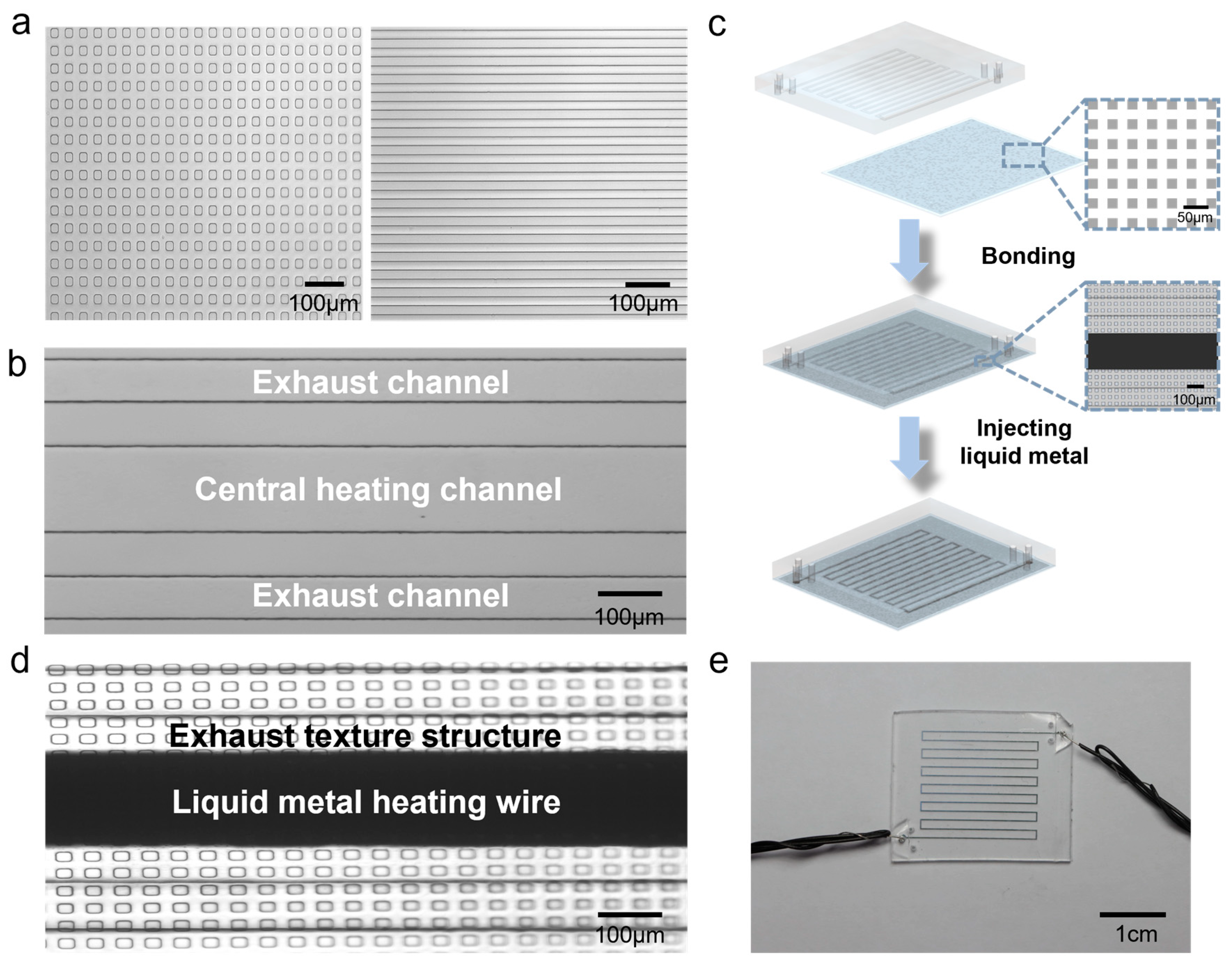
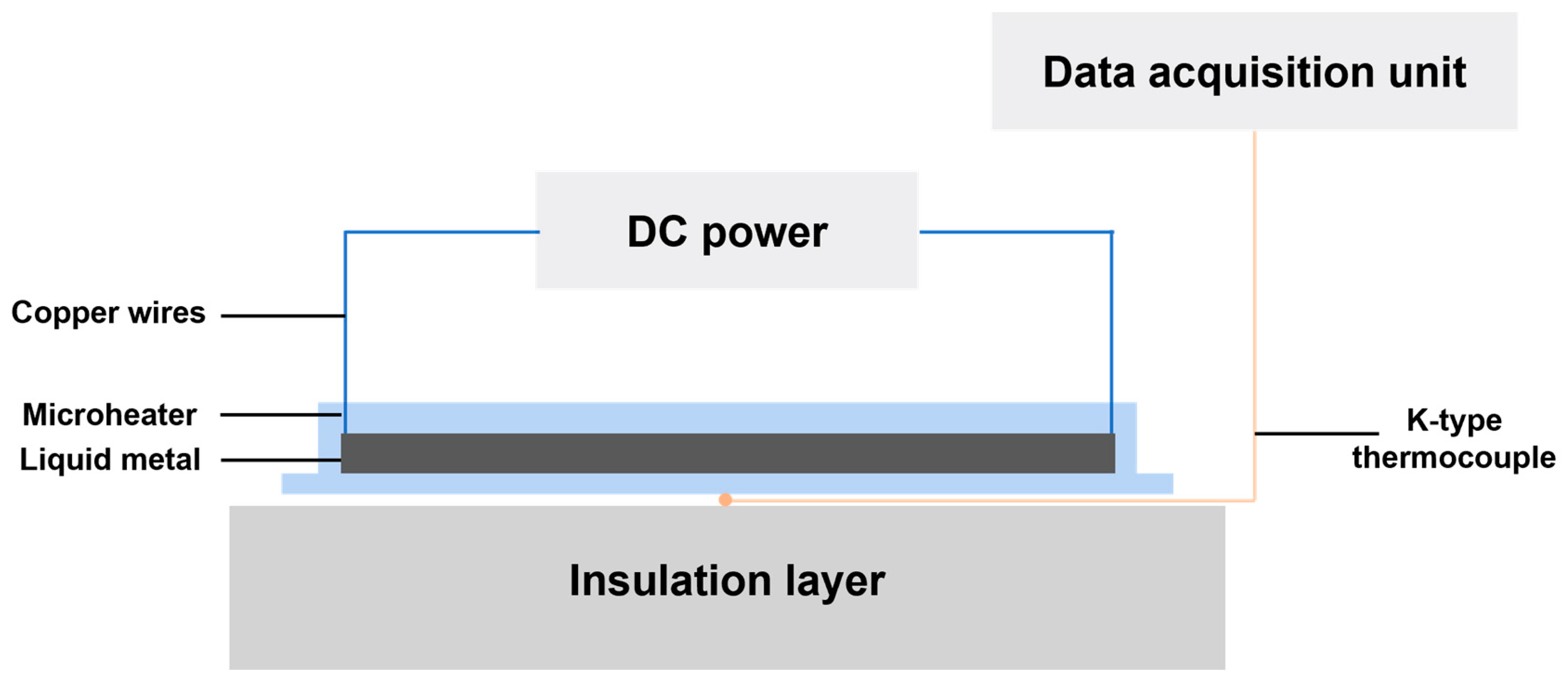

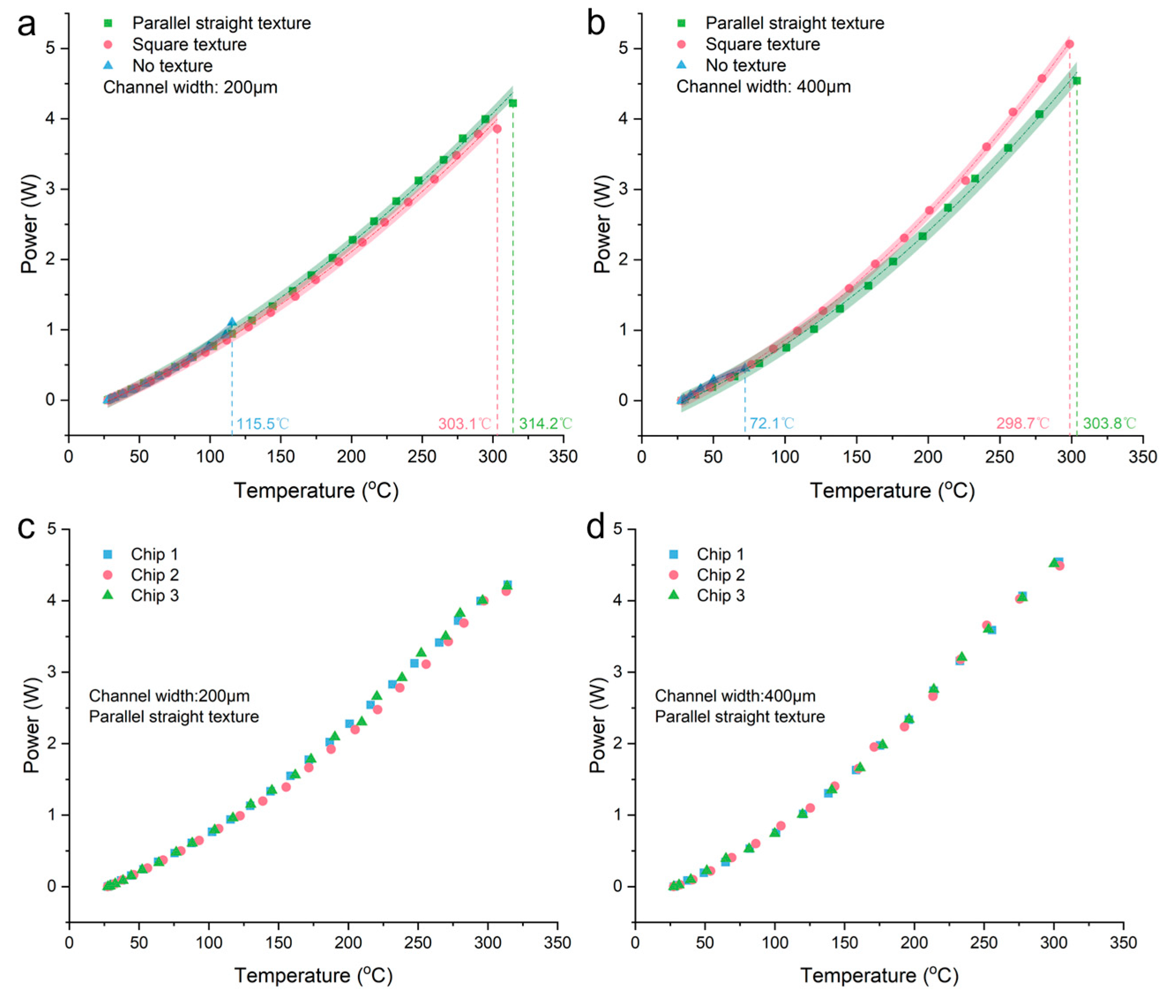
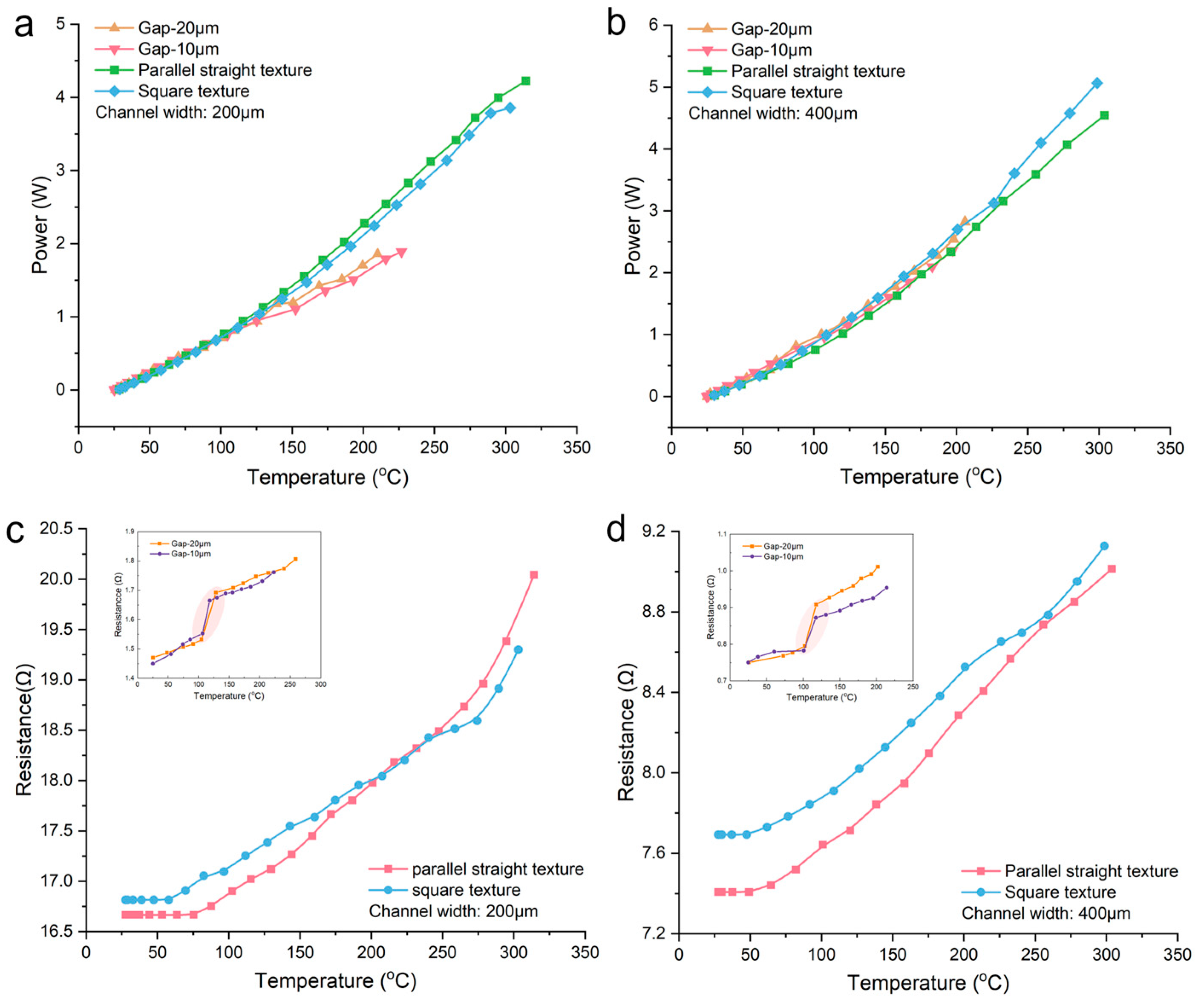

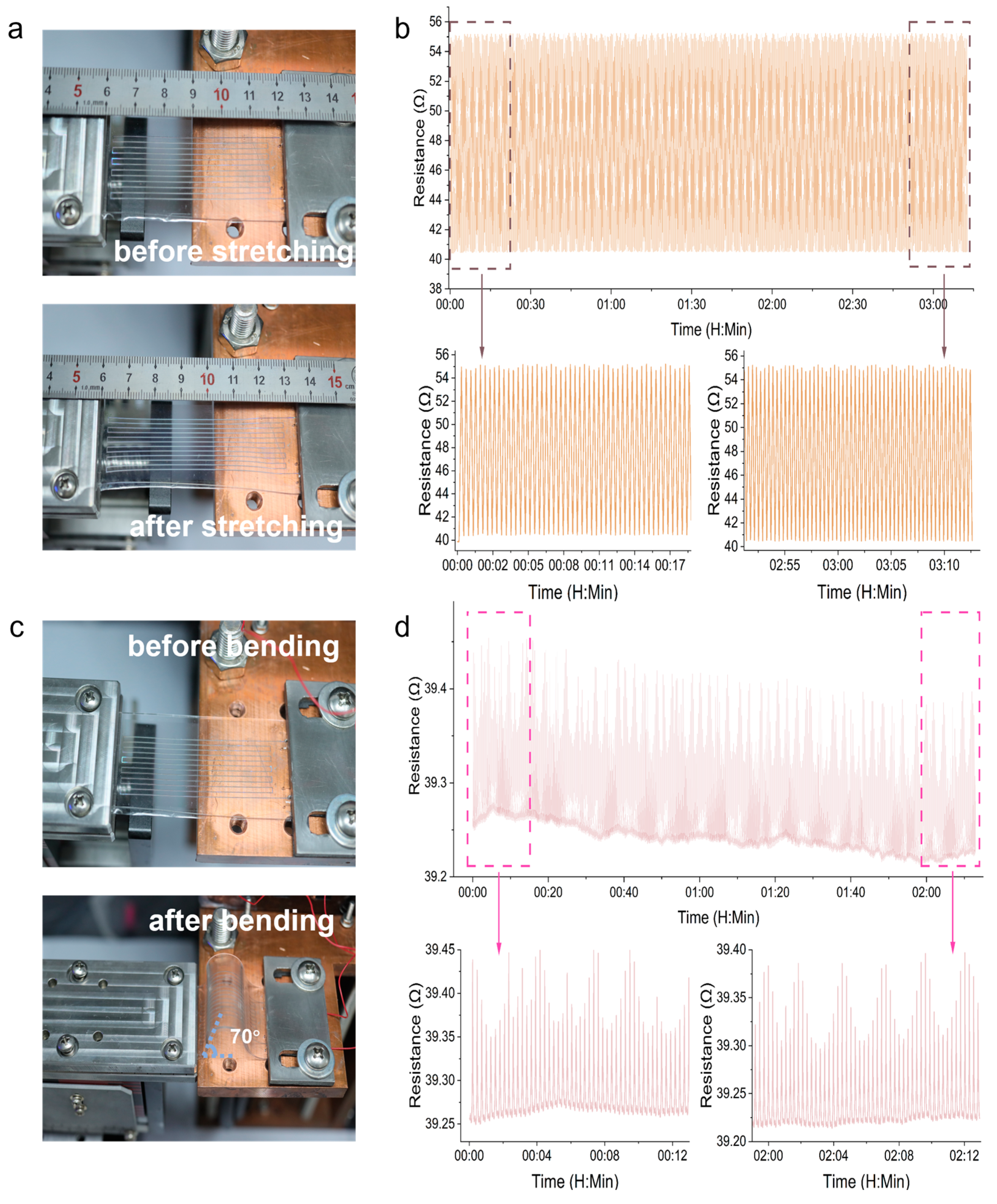

| Width of Channels (µm) | Bottom Film Type | Highest Temperature (°C) | Corresponding Voltage (V) |
|---|---|---|---|
| 200 | Parallel straight texture | 314.2 | 9.2 |
| Square texture | 303.1 | 8.4 | |
| No texture | 115.5 | 4.4 | |
| 400 | Parallel straight texture | 303.8 | 6.4 |
| Square texture | 298.7 | 6.8 | |
| No texture | 72.1 | 2.4 |
Disclaimer/Publisher’s Note: The statements, opinions and data contained in all publications are solely those of the individual author(s) and contributor(s) and not of MDPI and/or the editor(s). MDPI and/or the editor(s) disclaim responsibility for any injury to people or property resulting from any ideas, methods, instructions or products referred to in the content. |
© 2023 by the authors. Licensee MDPI, Basel, Switzerland. This article is an open access article distributed under the terms and conditions of the Creative Commons Attribution (CC BY) license (https://creativecommons.org/licenses/by/4.0/).
Share and Cite
Li, Y.; Zhang, H.; Ye, Z.; Liu, M.; Liu, W.; Li, Z.; Gui, L. A Novel Flexible Liquid Metal Microheater with a Textured Structure. Micromachines 2024, 15, 75. https://doi.org/10.3390/mi15010075
Li Y, Zhang H, Ye Z, Liu M, Liu W, Li Z, Gui L. A Novel Flexible Liquid Metal Microheater with a Textured Structure. Micromachines. 2024; 15(1):75. https://doi.org/10.3390/mi15010075
Chicago/Turabian StyleLi, Yuqing, Huimin Zhang, Zi Ye, Mingyang Liu, Wei Liu, Zhenming Li, and Lin Gui. 2024. "A Novel Flexible Liquid Metal Microheater with a Textured Structure" Micromachines 15, no. 1: 75. https://doi.org/10.3390/mi15010075
APA StyleLi, Y., Zhang, H., Ye, Z., Liu, M., Liu, W., Li, Z., & Gui, L. (2024). A Novel Flexible Liquid Metal Microheater with a Textured Structure. Micromachines, 15(1), 75. https://doi.org/10.3390/mi15010075







